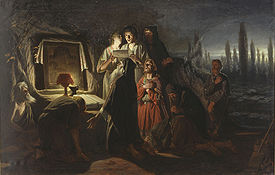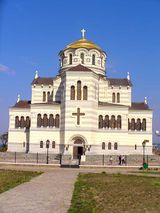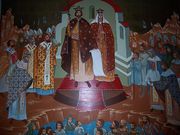Christianization of Kievan Rus'

The Christianization of Kievan Rus'[1] took place in several stages. In early 867, Patriarch Photius of Constantinople announced to other Orthodox patriarchs that the Rus, baptised by his bishop, took to Christianity with particular enthusiasm. Photius's attempts at Christianizing the country seem to have entailed no lasting consequences, since the Primary Chronicle and other Slavonic sources describe the tenth-century Rus as firmly entrenched in paganism. The definitive Christianisation of Kiev dates from the late 980s (the year is disputed[2]), when Vladimir the Great was baptized at Chersonesos, proceeding to baptize his family and people in Kiev. The place of Vladimir's baptism is marked by St. Vladimir's Cathedral.
Contents |
Ninth century
| Part of a series on |
| Eastern Christianity |
|---|

Eastern Christianity portal
|
| History |
| Byzantine Empire Crusades Ecumenical council Christianization of Bulgaria Christianization of Kievan Rus' East-West Schism By region Asian · Coptic Eastern Orthodox Georgian · Ukrainian |
| Traditions |
| Church of the East Eastern Catholic Churches Eastern Orthodox Church Oriental Orthodoxy Syriac Christianity |
| Liturgy and worship |
| Sign of the cross Divine Liturgy Iconography Asceticism Omophorion |
| Theology |
| Hesychasm · Icon Apophaticism Filioque clause Miaphysitism Monophysitism Nestorianism Theosis · Theoria Phronema · Philokalia Praxis · Theotokos Hypostasis · Ousia Essence vs. Energies Metousiosis |
The most authoritative source for the early Christianization of Rus is an encyclical letter of Patriarch Photius, datable to early 867. Referencing the Siege of Constantinople of 860, Photius informs the Oriental patriarchs and bishops that, after the Bulgarians turned to Christ in 863 [3], the Rus' followed suit. As was the case with the Bulgarians, the Patriarch found it prudent to send to the barbarians a bishop from Constantinople.[4] With some modifications, the story is repeated by Constantine VII in De Administrando Imperio, followed by several generations of Byzantine historians, including John Skylitzes and John Zonaras. That the imperial court and patriarchate regarded the 10th-century Rus' as Christians is evident from the fact that the bishopric of Rus' was enumerated in the lists of Orthodox sees, compiled during the reigns of Leo the Wise and Constantine VII. There is also an argumentum ex silentio: no Greek source recorded the second baptism of the Rus in the 990s.
Tenth century
Whatever the scope of Photius's efforts to Christianize the Rus, their effect was not lasting. Although they fail to mention the mission of Photius, the authors of the Primary Chronicle were aware that a sizable portion of the Kievan population was Christian by 944. In the Russo-Byzantine Treaty, preserved in the text of the chronicle, the Christian part of the Rus swear according to their faith, while the ruling prince and other non-Christians invoke Perun and Veles after the pagan custom. The Kievan collegiate church of St. Elijah (whose cult in the Slavic countries was closely modeled on that of Perun) is mentioned in the text of the chronicle, leaving modern scholars to ponder how many churches existed in Kiev at the time.
Either in 945 or 957, the ruling regent, Olga of Kiev, visited Constantinople with a certain priest, Gregory. Her reception at the imperial court is described in De Ceremoniis. Although it is usually presumed that she was baptized in Constantinople rather than Kiev, there is no explicit mention of the sacrament, so neither version is excluded. Olga is also known to have requested a bishop and priests from Rome.[5] Her son, Sviatoslav (r. 963-972), continued to worship Perun and other gods of the Slavic pantheon. He remained a stubborn pagan all of his life; according to the Primary Chronicle, he believed that his warriors would lose respect for him and mock him if he became a Christian.
Svyatoslav's successor, Yaropolk I (r. 972-980), seems to have had a more conciliatory attitude towards Christianity. Late medieval sources even claim that Yaropolk exchanged ambassadors with the Pope. The Chronicon of Adémar de Chabannes and the life of St. Romuald (by Pietro Damiani) actually document the mission of St. Bruno of Querfurt to the land of Rus, where he succeeded in converting to Christianity a local king (one of three brothers who ruled the land). Alexander Nazarenko suggests that Yaropolk went through some preliminary rites of baptism, but was murdered at the behest of his pagan half-brother Vladimir (whose own rights to the throne were questionable) before his conversion was formalized. Following this theory, any information on Yaropolk's baptism according to the Latin rite would be suppressed by the later Orthodox chroniclers, zealous to keep Vladimir's image of the Russian Apostle untarnished for succeeding generations.[6]
Vladimir's baptism of Kiev
Background


During the first decade of Vladimir's reign, pagan reaction set in. Perun was chosen as the supreme deity of the Slavic pantheon and his idol was placed on the hill by the royal palace. This revival of paganism was contemporaneous with similar attempts undertaken by Jarl Haakon in Norway and (possibly) Svein Forkbeard in Denmark. Although Vladimir seems to have gone further than both Scandinavian konungs (even human sacrifices were reported in Kiev), his religious reform failed. By the late 980s he had found it necessary to adopt monotheism from abroad.
The Primary Chronicle reports that in the year 987, as the result of a consultation with his boyars, Vladimir sent envoys to study the religions of the various neighboring nations whose representatives had been urging him to embrace their respective faiths. The result is amusingly described in the following apocryphal anecdote. Of the Muslim Bulgarians of the Volga the envoys reported there is no gladness among them; only sorrow and a great stench. They also said that their religion was undesirable due to its taboo against alcoholic beverages and pork; supposedly, Vladimir said on that occasion: "Drinking is the joy of the Rus'."
Russian sources also describe Vladimir consulting with Jewish envoys (who may or may not have been Khazars), and questioning them about their religion but ultimately rejecting it, saying that their loss of Jerusalem was evidence of their having been abandoned by God.
Ultimately Vladimir settled on Christianity. In the gloomy churches of the Germans his emissaries saw no beauty; but at Hagia Sophia, where the full festival ritual of the Byzantine Church was set in motion to impress them, they found their ideal: "We no longer knew whether we were in heaven or on earth," they reported, "nor such beauty, and we know not how to tell of it." If Vladimir was impressed by this account of his envoys, he was yet more so by political gains of the Byzantine alliance.
Baptism of Vladimir

Foreign sources, very few in number, present the following story of Vladimir's conversion. Yahya of Antioch and his followers (al-Rudhrawari, al-Makin, al-Dimashki, and ibn al-Athir)[7] give essentially the same account. In 987, the generals Bardas Sclerus and Bardas Phocas revolted against the Byzantine emperor Basil II. Both rebels briefly joined forces and advanced on Constantinople. On September 14, 987, Bardas Phocas proclaimed himself emperor. Anxious to avoid the siege of his capital, Basil II turned to the Rus for assistance, even though they were considered enemies at that time. Vladimir agreed, in exchange for a marital tie; he also agreed to accept Orthodox Christianity as his religion and bring his people to the new faith. When the wedding arrangements were settled, Vladimir dispatched 6,000 troops to the Byzantine Empire and they helped to put down the revolt.[8]
|
|||||
In the Primary Chronicle, the account of Vladimir's baptism is preceded by the so-called Korsun' Legend. According to this apocryphal story, in 988 Vladimir captured the Greek town of Korsun' (Chersonesos) in Crimea, highly important commercially and politically. This campaign may have been dictated by his wish to secure the benefits promised to him by Basil II, when he had asked for the Rus' assistance against Phocas. In recompense for the evacuation of Chersonesos, Vladimir was promised the hand of the emperor's sister, Anna Porphyrogeneta. Prior to the wedding, Vladimir was baptized (either in Chersonesos or in Kiev), taking the Christian name of Basil out of compliment to his imperial brother-in-law. The sacrament was followed by his marriage with the Greek princess.[9]
Baptism of Kiev

Returning to Kiev in triumph, Vladimir exhorted the residents of his capital to the Dnieper river for baptism. This mass baptism became the iconic inaugural event in the Christianization of the state of Kievan Rus'.
At first Vladimir baptised his 12 sons and many boyars. He destroyed the wooden statues of Slavic pagan gods (which he had himself raised just eight years earlier). They were either burnt or hacked into pieces, and the statue of Perun — the supreme god — was thrown into the Dnieper. Then he sent a message to all residents of Kiev, "rich, and poor, and beggars, and slaves", to come to the river on the following day, lest they risk becoming the "prince's enemies". Large number of people came; some even brought infants with them. They were sent into the water while Orthodox priests, who came from Chersonesos for the occasion, prayed.[10]
To commemorate the event, Vladimir built the first stone church of Kievan Rus', called the Church of the Tithes, where his body and the body of his new wife were to repose. Another church was built on top of the hill where pagan statues stood before.[11]
Aftermath
The baptism of Kiev was followed by similar ceremonies in other urban centres of the country. The Ioakim Chronicle says that Vladimir's uncle, Dobrynya, forced the Novgorodians into Christianity "by fire", while the local mayor, Putyata, persuaded his compatriots to accept Christian faith "by the sword". At that same time, Bishop Ioakim Korsunianin built the first, wooden, Cathedral of Holy Wisdom "with 13 tops" on the site of a pagan cemetery.[12] Paganism persisted in the country for a long time, surfacing during the Upper Volga Uprising and other occasional pagan protests. The northeastern part of the country, centred on Rostov, was particularly hostile to the new religion. Novgorod itself faced a pagan uprising as late as 1071, in which Bishop Fedor faced a real threat to his person; Prince Gleb Sviatoslaich broke up the crowd by chopping a sorcerer in half with an axe.[13]

The Christianisation of Kievan Rus' firmly allied it with the Byzantine Empire. The Greek learning and book culture was adopted in Kiev and other centres of the country. Churches started to be built on the Byzantine model. During the reign of Vladimir's son Yaroslav I, Metropolitan Ilarion authored the first known work of East Slavic literature, an elaborate oration in which he favourably compared Rus to other lands known as "the Sermon on Law and Grace". The Ostromir Gospels, produced in Novgorod during the same period, was the first dated East Slavic book. But the only surviving work of lay literature, The Tale of Igor's Campaign, testifies to the survival of pagan worldview under this Christian facade.
In 1988, the faithful of the Eastern Orthodox churches which have roots in the baptism of Kiev celebrated a millennium of Eastern Slavic Christianity. The great celebrations in Moscow changed the character of relationship between the Soviet state and the church. For the first time since 1917, numerous churches and monasteries were returned to the Russian Orthodox Church. In Ukrainian communities around the world, members of various Ukrainian churches also celebrated the Millennium of Christianity in Ukraine.
See also
- Baptism of Poland
- St. Vladimir's Cathedral
References
- ↑ In Russian-language (as well as Ukrainian) literature, the term "baptism of Rus'" (Russian: Крещение Руси) is often used, primarily to designate the events of 988.
- ↑ See Oleg M. Rapov, Russkaya tserkov v IX–pervoy treti XII veka (The Russian Church from the 9th to the First 3rd of the 12th Century). Moscow, 1988.
- ↑ History of the Bulgarians from Antiquity to the 16th Century by Georgi Bakalov (2003) ISBN 954-528-289-4
- ↑ Photii Patriarchae Constantinopolitani Epistulae et Amphilochia. Eds.: B. Laourdas, L.G. Westerinck. T.1. Leipzig, 1983. P. 49.
- ↑ Thietmar of Merseburg says that the first archbishop of Magdeburg, Adalbert of Prague, before being promoted to this high rank, was sent by Emperor Otto to the country of the Rus (Rusciae) as a simple bishop but was expelled by pagans. The same data is duplicated in the annals of Quedlinburg and Hildesheim, among others.
- ↑ Alexander Nazarenko. Древняя Русь на международных путях. Moscow, 2001. ISBN 5-7859-0085-8.
- ↑ Ibn al-Athir dates these events to 985 or 986.
- ↑ Golden, P.B. (2006) "Rus." Encyclopaedia of Islam (Brill Online). Eds.: P. Bearman, Th. Bianquis, C.E. Bosworth, E. van Donzel and W.P. Heinrichs. Brill.
- ↑ Lavrentevskaia Letopis, also called the Povest Vremennykh Let, in Polnoe Sobranie Russkikh Letopisei (PSRL), vol. 1, col.s 95-102.
- ↑ Lavrent. (PSRL 1), col. 102.
- ↑ Lavrent. (PSRL 1), cols. 108-109.
- ↑ Novgorodskaia tretiaia letopis, (PSRL 3), 208. On the initial conversion, see Vasilii Tatishchev, Istoriia rossiiskaia, A. I. Andreev, et al., eds. (Moscow and Leningrad: AN SSSR, 1962), vol. 1, pp. 112-113.
- ↑ Arsennii Nasonov, ed. Novgorodskaia Pervaia Letopis: Starshego i mladshego izvodov (Moscow and Leningrad: AN SSSR, 1950), pp. 191-96.
|
||||||||||||||||||||||||||||||||||||||||||
